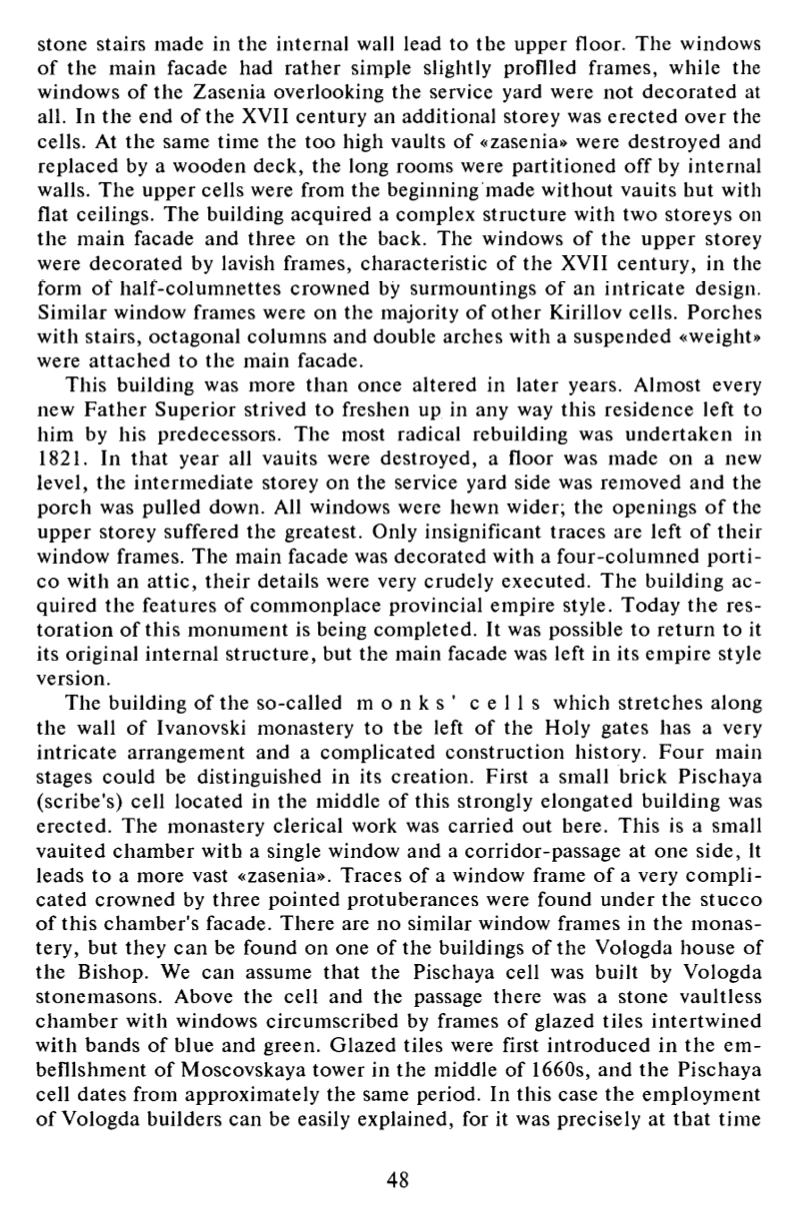

stone stairs made in the internal wall lead to the upper floor. The windows
o f the main facade had rather simple slightly profiled frames, while the
windows of the Zasenia overlooking the service yard were not deco ra ted at
all. In the end o f the XVII century an additional storey was erected over the
cells. At the same time the too high vaults of «zasenia» were destroyed and
replaced by a wooden deck, the long rooms were partitioned off by internal
walls. The upper cells were from the beginning made without vauits hut with
flat ceilings. The building acquired a complex structure with two storeys on
the main facade and three on the back. The windows of the upper storey
were decorated by lavish frames, characteristic of the XVII century, in the
form o f half-co lumnettes crowned by surmountings o f an intricate design.
Similar window frames were on the majority o f o ther Kirillov cells. Porches
with stairs, octagonal columns and double arches with a suspended «weight»
were a ttached to the main facade.
This building was more than once altered in later years. Almost every
new Fa the r Superior strived to freshen up in any way this residence left to
h im by his predecessors. The most radical rebuilding was unde rtaken in
1821. In that year all vauits were destroyed, a floor was made on a new
level, the intermediate storey on the service yard side was removed and the
porch was pulled down. All windows were hewn wider; the openings o f the
upper storey suffered the greatest. Only insignificant traces are left o f their
window frames. The main facade was decorated with a fou r-co lumned po r ti
co with an attic, their details were very crudely executed. The building a c
quired the features of commonplace provincial empire style. Today the res
to ra tion o f this monumen t is being completed. It was possible to return to it
its original internal structure, but the main facade was left in its empire style
version.
The building of the so-called m o n k s ' c e l l s which stretches along
the wall o f Ivanovski monastery to the left o f the Holy gates has a very
in tricate arrangement and a complicated construction history. Four main
stages could be distinguished in its creation. First a small brick Pischaya
(scribe's) cell located in the middle of this strongly elongated building was
erected. The monastery clerical work was carried out here. This is a small
vauited chamber with a single window and a corridor-passage at one side, it
leads to a more vast «zasenia». Traces of a window frame o f a very c om p li
cated crowned by three pointed protuberances were found under the stucco
o f this chamber's facade. There are no similar window frames in the mon a s
tery, but they can be found on one of the buildings of the Vologda house of
the Bishop. We can assume that the Pischaya cell was built by Vologda
stonemasons. Above the cell and the passage there was a stone vaultless
chambe r with windows circumscribed by frames o f glazed tiles in tertwined
with bands of blue and green. Glazed tiles were first in troduced in the em-
befllshment o f Moscovskaya tower in the middle of 1660s, and the Pischaya
cell dates from approximately the same period. In this case the employmen t
o f Vologda builders can be easily explained, for it was precisely at tha t time
48















